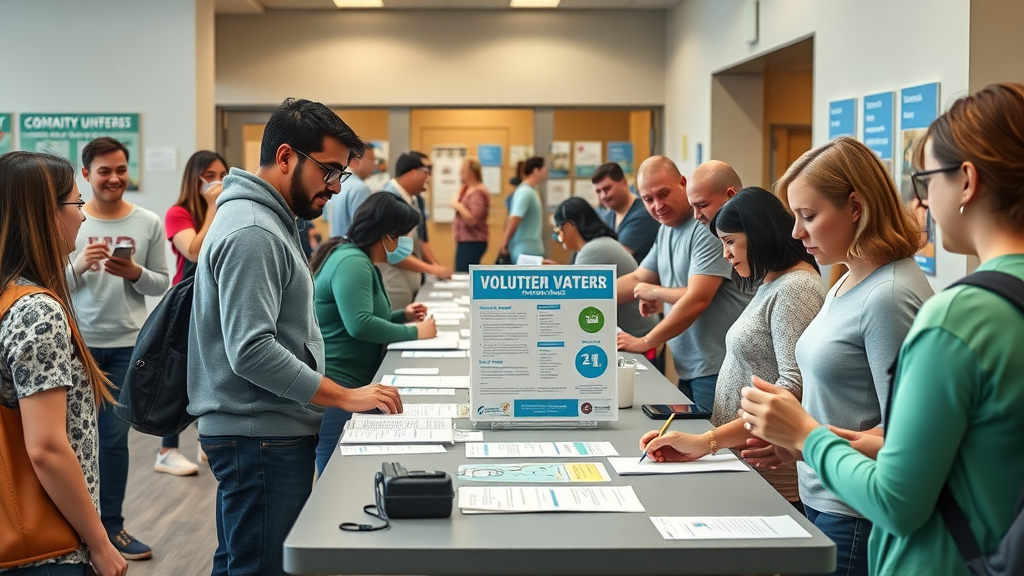If you've ever wondered whether you can truly make a difference in a young person's life, the answer is yes. Every day, ordinary people become role models and change agents, guiding troubled teens toward hope, purpose, and brighter futures. Through compassion and volunteer service, you not only lift up young people—you strengthen the heartbeat of entire communities. Whether you’re a parent, college student, or community leader, learning how to support and inspire teens in need could be the most rewarding journey you ever take.
Opening the Door: The Power of Volunteering for Troubled Teens
When you choose to get involved in volunteering for troubled teens, you are opening the door to transformation—not just for the youths themselves, but for families, neighborhoods, and your local community. Troubled teens often face obstacles that can seem insurmountable: struggles with mental health, difficult home environments, academic pressures, or the challenges of growing up in underserved communities. Youth programs and community service efforts provide a vital safety net, where young people can develop life skills, connect with positive role models, and discover the value of giving back.
In the United States, thousands of volunteers become mentors, tutors, and supporters for teens each year, creating countless success stories. By getting involved, you help bridge critical gaps that exist for at-risk youth—from building confidence to opening paths toward higher education or a successful gap year. The real reward is witnessing positive change: teens becoming stronger, families finding hope, and neighborhoods uniting together for a brighter tomorrow.
"Participating in volunteering for troubled teens doesn't just help young people—it changes entire communities."

What You'll Learn
The benefits of volunteering for troubled teens
How community service and youth programs promote growth
Actionable steps to get involved in volunteer opportunities
Impact stories: real-world examples from youth programs
Understanding the Need: Why Volunteering for Troubled Teens Matters
The Challenges Facing Troubled Teens
Troubled teens face a unique set of obstacles in today’s world. Many grapple with mental health issues such as anxiety and depression, often compounded by challenges at school or home. Some may experience bullying, academic stress, or family instability, while others feel isolated as they navigate the pressure to fit in. According to social work professionals, these challenges can lead to risky behaviors or disengagement from school and family life.
For teens growing up in underserved communities—whether in North Carolina or the heart of a big city—access to positive guidance and leadership roles can be limited. Without meaningful support, these young people are at risk of falling through the cracks, facing lifelong consequences such as lower self-worth, poor academic achievement, and strained relationships. Community volunteer efforts are more important than ever as a link to hope, connection, and new beginnings. By stepping forward as a role model, mentor, or program volunteer, you help fill these critical gaps and strengthen the local community.

How Community Service and Youth Programs Address These Challenges
The path to positive change often begins with connections fostered through youth programs and community service. These initiatives provide safe spaces where teens can explore interests, receive guidance from young professionals, and learn important life skills such as effective communication and financial literacy. By participating in volunteer opportunities, troubled teens see firsthand the value of teamwork, responsibility, and giving back, lessons that shape their character for years to come.
Community service projects—ranging from local habitat improvements to high school tutoring programs—not only offer constructive activities, but also instill a sense of pride and accomplishment. When teens are surrounded by supportive adults and role models, they are less likely to engage in negative behaviors and more likely to make healthy choices. Volunteering isn't just about what you give—it's also about what you receive: powerful connections, personal growth, and the satisfaction of knowing your efforts make a positive impact.
"A single act of kindness through volunteer service can redirect a life."
Volunteering for Troubled Teens: Key Benefits
Social and Emotional Growth through Volunteer Service
One of the greatest rewards of volunteering for troubled teens is witnessing social and emotional growth, both for the young people and the volunteers themselves. For teens, participating in youth programs can foster a sense of belonging and acceptance that’s often missing at home or school. Regular interaction with positive adult role models and peer mentors helps them develop critical interpersonal skills: active listening, effective communication, empathy, and respect for diversity.
These new relationships provide a support network that guides teens through difficult emotions and major life decisions. As confidence increases, teens become more engaged in school, friendships, and community activities. Volunteers, in turn, experience a deep sense of fulfillment knowing they are making a positive impact and, in many cases, transforming lives for the better in their local communities.

Boosting Self-Esteem and Reducing Risk Behaviors
When troubled teens become involved in volunteer programs, the benefits extend far beyond skill-building. Engaging with their communities fosters a sense of purpose and self-worth, encouraging them to pursue healthier behaviors and aspirations. Numerous studies—including those by state universities and social work organizations—show teens who participate regularly in community service or mentorship programs develop higher self-esteem, stronger academic engagement, and a reduced likelihood of engaging in risky behaviors.
Additionally, involving family members or young professionals as mentors helps teens see firsthand that positive change is possible and accessible. These direct connections serve as powerful reminders that they are not alone, and that people in their local community care about their well-being and success. Over time, volunteering works to replace negative patterns with proactive, confident, and motivated attitudes—opening doors to leadership roles and brighter futures.
Comparison of Outcomes: Teens Involved in Volunteering vs. Those Not Involved |
||
Outcome |
Teens in Volunteer Programs |
Teens Not Involved |
|---|---|---|
Academic Engagement |
Higher (more likely to graduate high school) |
Lower (at risk of dropping out) |
Self-Esteem |
Significantly Improved |
Often Decreased |
Risky Behaviors |
Less Frequent |
More Frequent |
Sense of Belonging |
Strong Network (role models, peers) |
Feelings of Isolation |
Long-Term Success |
Increased Leadership, College Pathways |
Missed Opportunities |
Types of Volunteer Opportunities for Troubled Teens

Youth Programs: Mentorship, Tutoring, and After-School Activities
There are many ways to get involved in youth programs that directly support troubled teens. Mentorship is a powerful tool, giving young people the chance to form lasting bonds with community leaders, young professionals, or even college students from a state university. Through regular meetings and shared experiences, mentors help teens navigate challenges, set goals, and find purpose.
Tutoring provides valuable educational support, especially for teens struggling academically or preparing for graduation. After-school activities—from STEM clubs to sports or art—offer fun, constructive outlets and keep teens engaged in positive environments. Whether you’re skilled in financial literacy, creative arts, or just passionate about helping, there’s a youth program that can use your unique talents to make a positive impact.
Community Service: Local Habitat and Environmental Projects
Community service creates hands-on volunteer opportunities that benefit both teens and the neighborhoods they call home. Local habitat restoration projects, such as park cleanups or urban gardening, not only teach responsibility and teamwork, but also connect youths to the world around them. Many high school and college student groups partner with nonprofits to organize tree plantings, recycling drives, or mural painting—creating pride and beautifying the local community.
Engaging in environmental stewardship allows troubled teens to develop leadership roles, practice social work principles, and give back in ways that are tangible and immediately rewarding. For volunteers, these projects provide a sense of accomplishment and the joy of making a positive change together. The skills and confidence gained through community service can guide teens toward brighter futures and increase their motivation for lifelong learning and civic engagement.
High School Partnerships and Youth Program Collaborations
High school partnerships are another crucial avenue for supporting troubled teens. Many schools have existing collaborations with community organizations or youth programs that focus on outreach, educational mentoring, and volunteer service. By connecting with guidance counselors or volunteer coordinators, you can identify where your time and passion will be most valuable.
Youth program collaborations bring together business leaders, young professionals, and motivated family members to create a sustained network of support. These collective efforts build positive relationships across generations, inspire high school students to pursue ambitious goals, and offer a pathway for community volunteers eager to help. Through these partnerships, teens see that adults in their community truly care about their development and success, reinforcing their sense of belonging and hope.
How to Get Involved in Volunteering for Troubled Teens

Finding Local Volunteer Opportunities
Ready to take the next step? Finding local volunteer opportunities for troubled teens is easier than you might think. Start by reaching out to your nearest recreation center, high school, or community service organization. Many groups actively seek mentors, tutors, and after-school activity coordinators for their youth programs. Online volunteer matching platforms and local nonprofit directories can connect you to organizations that align with your skills and schedule.
Consider joining collaborative events hosted by community leaders, business leaders, or even your local habitat protection group. Many colleges and state university chapters have student-run programs focused on making a positive impact. By exploring volunteer opportunities within your county or city, you’ll find programs where your efforts and passion for serving youth are needed most. Don’t hesitate to ask for a volunteer coordinator’s guidance—they can offer helpful tips, training sessions, and valuable insight into the needs of teens in your community.
Steps to Start Your Own Youth Program
If existing programs don’t match your vision, consider taking initiative and starting your own youth program for troubled teens. Begin by identifying the needs in your neighborhood or school district—for example, the lack of after-school tutoring, mentorship, or community service opportunities. Build partnerships with local nonprofits, social work organizations, and supportive businesses who share your goals for positive change.
Engage a broad range of volunteers, including family members, young professionals, and older students with leadership backgrounds. Develop a clear mission, accessible structure, and outreach plan. Giving back isn’t just a catchphrase—it’s a movement you help bring to life, one teen at a time. Organizational resources, grant funding, and ongoing community support will ensure your program grows and evolves, offering life-changing experiences for years to come.
Contact community centers and schools
Partner with local nonprofits focused on youth programs
Engage family members and young professionals as volunteers
Real Stories: Transformation Through Volunteering for Troubled Teens
Family Member Perspectives on Volunteer Service
One of the most powerful testaments to the impact of volunteering for troubled teens comes from family members. Parents, siblings, and grandparents often report seeing dramatic improvements in teens’ confidence, motivation, and resilience after participating in youth programs. Family members share stories of once-withdrawn teens blossoming into engaged community members, inspired by the compassion of a role model or the structure of a volunteer program.
These personal accounts remind us that every small action—whether tutoring homework or organizing a community service event—creates ripple effects that support the entire family. When a teen thrives, relationships at home often improve, and new opportunities for growth and understanding emerge for everyone involved. Volunteering doesn’t just build better teens—it builds better bonds and brighter futures for families.
The Influence of Young Professionals in Youth Programs
Young professionals play a unique and valuable role in youth programs. Their fresh outlook and recent life experiences often resonate deeply with teens, who are striving to envision their own futures. These volunteers may be college students, business professionals, or community leaders who see the value in giving back. By sharing their stories and offering guidance, young professionals illustrate that success is achievable—no matter the obstacles faced in high school or beyond.
Whether through mentorship, teaching skills like financial literacy, or supporting local projects, the impact of this group is profound. Young professionals help troubled teens see what’s possible when you set goals and commit to making a positive change, both for yourself and your community. Their active involvement inspires future leaders and demonstrates that every generation can contribute to social growth and empowerment.
People Also Ask
How can volunteering help troubled teens?
Volunteering offers troubled teens a way to connect with supportive mentors, develop vital life skills, and gain a sense of belonging. By participating in youth programs and community service, teens learn the value of teamwork, responsibility, and giving back, which helps build confidence and reduce risky behaviors. Volunteering also creates networks of compassionate adults and peers, providing guidance and hope that can transform lives.
What are the best youth programs for troubled teens?
The best youth programs for troubled teens are those that offer mentorship, educational support, and positive activities in a safe environment. Look for established community service organizations, after-school mentorships, local habitat projects, and school-based collaborations. Programs led by young professionals and supported by family members often provide personalized guidance and lasting impact, helping teens overcome challenges and find their strengths.
What challenges do troubled teens face when seeking volunteer opportunities?
Troubled teens may face barriers such as lack of access to transportation, limited awareness of available programs, or hesitation due to low self-esteem. Some worry about feeling unwelcome or judged, especially if they have struggled academically or socially. Support from families, teachers, and volunteer coordinators is essential to help teens overcome these obstacles and discover community service options that match their needs.
Answer: How can volunteering help troubled teens?

Volunteering gives troubled teens a path toward healing, growth, and self-discovery. When surrounded by positive role models and supportive peers, teens develop new skills and confidence. They learn to trust, communicate, and work as part of a team—attributes that empower their future success. Through acts of community service, teens shift from feeling powerless to realizing they can make a difference for themselves and others.
Answer: What are the best youth programs for troubled teens?
Top youth programs include local mentorship initiatives, after-school tutoring, community service projects, and leadership-building organizations. Programs affiliated with high schools or local nonprofits allow for regular, structured support. Look for options that encourage participation from family members and young professionals, offering a range of activities from sports and art to environmental stewardship and financial literacy training. The variety ensures every teen finds something that sparks their interest and motivates engagement.
Answer: What challenges do troubled teens face when seeking volunteer opportunities?
Some key obstacles troubled teens encounter include lack of confidence, fear of stigma, limited resources, and difficulties with transportation or scheduling. Parental involvement, supportive teachers, and patient volunteer coordinators can bridge these gaps by providing information, encouragement, and flexible options. Over time, successful participation in youth programs diminishes these challenges and builds the skills necessary for lifelong positive change.
Key Takeaways on Volunteering for Troubled Teens
Volunteering for troubled teens builds life skills and confidence.
Community service and youth programs offer essential guidance.
Active involvement benefits teens, families, and entire communities.
Frequently Asked Questions: Volunteering for Troubled Teens
How do I find volunteer service roles for troubled teens?
You can find volunteer service roles by connecting with local community centers, high schools, and nonprofit organizations focused on youth development. Online volunteer matching sites and state university programs also offer excellent opportunities for involvement. Don’t hesitate to reach out to youth program coordinators for guidance and to ask about flexible roles that match your skills and interests.
What skills do I need for volunteering with youth programs?
Patience, empathy, strong communication, and a willingness to learn are some of the most valuable skills. Experience in leadership, tutoring, or social work can be helpful, but the most important qualities are compassion and commitment. Training and resources are often provided by the organizations to equip volunteers for success in their roles with troubled teens.
Can family members participate in youth program volunteering?
Absolutely! Many youth programs encourage family members to participate. Family involvement can strengthen the impact of the volunteer program and help create a supportive environment for teens. Whether assisting with events, mentoring, or supporting educational activities, family participation is always a valued part of youth program success.
Conclusion: The Life-Changing Power of Volunteering for Troubled Teens
Every act of compassion sows the seeds for brighter futures—for teens, families, and communities. Be the spark that transforms a life by getting involved today.
Ready to Transform Lives? Find Volunteer Opportunities for Troubled Teens Today
Don’t wait—your support could be the turning point for a young person in need. Explore local volunteer opportunities, join a youth program, or start your own. Together, we create hope, growth, and real change.
 Add Row
Add Row  Add
Add 





Write A Comment